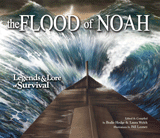
The Biami Legends of Creation and Noah’s Flood
Originally published in Creation 7, no 2 (October 1984): 12-13.
Fourteen years ago the Biami people were the last cannibal tribe of Papua New Guinea.
by Tom Hoey, Pioneer Missionary to the Biami People, New Guinea
with an introduction by John Mackay, B.Sc.
Much of the Biami folklore contained traces of the stories of Creation and Noah’s Flood as found in Genesis.The Biami people, numbering between four and five thousand, live in the western province of Papua New Guinea. Fourteen years ago they were the last cannibal tribe of Papua New Guinea. Thirteen years ago Tom Hoey and two other missionaries trekked into this area. After learning the language they discovered that much of the Biami folklore contained traces of the stories of Creation and Noah’s Flood as found in Genesis. Not only did Tom Hoey and the other workers find that the Biami people had preserved evidence that they were the descendants of those who left the Tower of Babel up to four millennia ago; they also found that these stories had prepared the natives to receive the good news about that Creator, Jesus Christ.
During the past thirteen years, many of the Biami people have become Christians. They have abandoned their cannibalism and heathen ways and in those thirteen years since missionaries entered the area, the Biami church has grown so strong that at present over fifteen outreach churches have been formed. The current leader of the church was the leading head-hunter of the tribe before he became a Christian.
The Biami Creation Story
At first the world was populated only by men.1 The first man2 in the world heard a small palm tree crying and crying. The man came to the small palm tree and it was put into his mind to begin to make a companion for himself. He took a knife3 and he carved the little palm tree into the shape of a woman.4 He carved all the woman's organs,5 and then he breathed the breath of life6 into the nostrils that he had carved in the palm tree. The woman became alive.
Footnotes
- The Biamis were fairly vague about how man came into existence. Genesis is very specific—God took dust and made Adam.
- The Biamis knew there was at least one man in the world at the beginning, but they were not sure whether there were any other men. Genesis is specific—there were no other men.
- The wording for knife could simply mean a sharp instrument of some kind.
- The palm tree could have been carved into the shape of a woman or girl.
- The description of the carving of the woman’s organs is somewhat obscene in some of the legends.
- When the Biamis hear the Genesis description of how the Lord Creator God breathed the Breath of Life into the first man Adam, they have a strong affinity with the Biblical origin of man since their story is so similar, yet they are far less certain of the details about which Genesis is so specific.
The Biami Flood
Once a great flood came which covered the whole earth and wiped out everyone on earth except for the ancestors of the Biami people.1 Those ancestors climbed up into the Gobia Tree the bark of which they make into string for their string bags. They took up into the tree their planting materials for crops, all their animals, their dogs and their pigs and everything else necessary for life. As the flood waters rose up on the face of the earth the people climbed further up the tree. They were safe in the branches of this tree because the tree grew up above the waters as the waters rose up.
When the waters went down from the surface of the whole earth, the people were able to climb down the tree. The ground was very muddy, but eventually they planted their crops and their animals began to reproduce. They moved away from the tree and began to repopulate the earth. Those who had climbed down out of the tree were the ancestors of the Samos, the Kubos, the Gobasis, and the Etoro.
Footnotes
- The Biami believe that the people who came down from that tree were the ancestors of the Biami people and all the other tribes immediately around them who, in their view, were the only people who existed since they knew of no others prior to the coming of the white missionaries.
- Note the similarities of this story to the Genesis account:
- There was a great flood.
- It destroyed all except a few people.
- They took all their animals and food plants.
- They were to repopulate the earth after the flood.
- Such stories provide anthropological evidence of the authenticity of the Biblical story of Noah’s Flood and the Tower of Babel.
Recommended Resources

Answers in Genesis is an apologetics ministry, dedicated to helping Christians defend their faith and proclaim the good news of Jesus Christ.
- Customer Service 800.778.3390
- © 2025 Answers in Genesis





